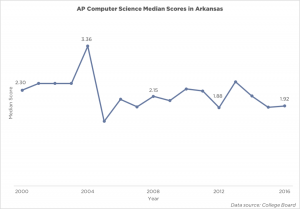“In the new economy, computer science isn’t an optional skill – it’s a basic skill, right along with the three “Rs.” President Obama made this bold declaration in January 2016, when he announced his Computer Science for All initiative, designed to expand computer science classes in public schools. While this presidential push marked the first concerted federal effort on the topic, the movement for expanded computer science education started long before.
As early as 2009, the organization, Technology Education and Literacy in Schools, started matching professional technologists with public schools to create more computer science classes. In 2013, another organization, Code.org was founded to achieve this same goal by introducing people to programming in a low-stakes, no experience required fashion. Other organizations, like Girls Who Code and Black Girls Code, have also sprung up to bridge the gap between the computer science workforce and primary school students.Despite all the excitement surrounding computer science education, not all states have high numbers of students learning computer science. Arkansas, in particular, is trailing behind others.
Advanced Placement classes teach curriculum designed by the College Board, and are offered to high school students as college-preparatory classes. Following completion of the course, students may take an optional AP Exam to demonstrate their mastery of the course content, and potentially earn college credit. While AP Computer Science is not the only way to learn computer science, participation in this curriculum provides a lens for analyzing the reach of computer science education. In Arkansas, there is a concerning lack of students who take the AP Computer Science exam compared to students taking other AP exams. In 2016, of the 47,415 Advanced Placement exams taken, only 0.64 percent of those — 304 tests — were for computer science. The most popular exam, AP English Language and Composition, had a 17.85 percent share with 8465 tests.
Despite the dearth of Arkansas AP Computer science students, enrollment is growing. As the above graph shows, the number of students taking the exam has been climbing steadily, with a large spike between 2014 and 2015. The increasing enrollment is thanks to the state’s many efforts to improve access to computer science education. Recently, the state began to require all public high schools and public charter schools to offer at least one computer science class. The law went into effect for the 2015–2016 school year, which explains the sudden increase in the number of students taking the AP Computer Science exam. While enrolling in the AP Computer Science class is not necessary for taking the exam, the class is an important source of preparation for students who plan to take the exam. The increasing numbers of test takers is indicative of expanded access to computer science education.
Arkansas also meets all of Code.org’s state goals for promoting computer science education, which includes establishing a state plan, a dedicated position in the state department of education, and standards for classes; helping teachers learn computer science; and providing incentives for students to enroll in classes. All of these efforts have combined to drastically increase participation in AP Computer Science among Arkansas students.

While enrollment may be growing, students’ scores remain low. The above graph shows the median score of AP Computer Science test takers. AP exams are graded on a scale of one to five, where scores three and above are considered passing. Scores in Arkansas have been consistently low, but have declined only slightly in recent years. It may be a good sign that the large increases in enrollment have not drastically lowered scores, meaning that the state’s resources are not strained even though there are more students taking the course. However, it is important to remember that 2016’s median score of 1.92, indicates a failing grade. While more students are taking the AP Computer Science Exam, this has not translated to increased content mastery. In order to truly expand access to computer science education, states like Arkansas must strive to provide quality education.
To reach its goal of expanding computer science education, Arkansas must now start investing in quality over quantity. Its existing laws can already help; for example, certifying teachers will help ensure teachers can teach the material properly and answer students’ questions competently. Furthermore, increased mentorship from professionals in the tech industry can also help ensure students can thoroughly learn the material. Currently, only one high school in Arkansas is part of the TEALS matching program, and expanding this program represents an opportunity to engage more students.
Computer science education is becoming increasingly important as technology starts to intersect with more fields and becomes a more central part of society. In order to prepare future generations to substantively engage in this field, computer science education must not only be accessible to as many students as possible in every state, but must also include high-quality instruction and mentorship that ensures deep engagement, true learning, and effective content mastery.
